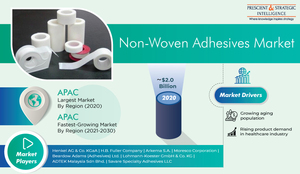Non-Woven Adhesives Market Prospering in Emerging Economies
Posted By Aryan Kumar
Body
The global non-woven adhesives market revenue stood at $2.0 billion in 2020, and it is predicted to surge rapidly between 2021 and 2030. The market is being propelled by the growing use of non-woven adhesives in baby care, adult incontinence applications, feminine hygiene products, rising public awareness about high-quality products, and mushrooming requirement for these adhesives in the textile industry. According to various reports, the healthcare business had a value of $8.5 trillion in 2018 and the global healthcare expenditure is expected to surpass $10 trillion by 2022.
This is predicted to push up the demand for non-woven adhesives, as these products provide safe and secure fixation, exhibit high absorption, and offer sterile dressing which massively mitigates the chances of contamination and ensures greater wound protection. Apart from this factor, the ballooning population of geriatric people is also fueling the expansion of the non-woven adhesives market. According to the World Population Aging 2020 report published by the United Nations Department of Economic and Social Affairs (UNDESA), the population of people aged 65 years and above will rise from 727 million in 2020 to more than 1.5 billion by 2050.
As geriatric people need adult diapers, which consist of non-woven hygienic adhesives, especially in developed nations, such as Japan, Western European countries, and the United States. In these countries, the industry for adult diapers is bigger than the industry for infant diapers. Depending on type, the non-woven adhesives market is divided into styrenic block copolymer (SBC), polyalpha olefin (APAO), and ethylene vinyl acetate (EVA). Amongst these, the APAO category contributed the highest revenue to the market in the past, and it is predicted to demonstrate rapid expansion in the forthcoming years.
This is attributed to the high shear resistance and peel strength that APAO imparts to baby hygiene and disposable adult products, which are experiencing high demand. Additionally, these materials are used in medical products, which are also witnessing growing demand across the world. Geographically, the Asia-Pacific (APAC) region held the largest share in the non-woven adhesives market in the years gone by, and this trend will continue in the coming years as well, as per the estimates of the market research company, P&S Intelligence.
This is attributed to the growing per capita income and low labor and material costs, which are fueling the development of hygiene product and non-woven adhesive producing facilities in the region. The players operating in the non-woven adhesives market are actively focusing on expanding their production capacities in order to cater to the rising consumer requirements. For example, Henkel Adhesives Technologies India Pvt. Ltd. unveiled a new production facility in Kurkumbh, India in February 2020, with an investment of nearly $57.0 million.
Hence, it can be safely said that the demand for non-woven adhesives will rise sharply in the coming years, primarily because of the surging healthcare spending, rising public awareness about various hygiene products, and growing geriatric population all over the world.
This is predicted to push up the demand for non-woven adhesives, as these products provide safe and secure fixation, exhibit high absorption, and offer sterile dressing which massively mitigates the chances of contamination and ensures greater wound protection. Apart from this factor, the ballooning population of geriatric people is also fueling the expansion of the non-woven adhesives market. According to the World Population Aging 2020 report published by the United Nations Department of Economic and Social Affairs (UNDESA), the population of people aged 65 years and above will rise from 727 million in 2020 to more than 1.5 billion by 2050.
As geriatric people need adult diapers, which consist of non-woven hygienic adhesives, especially in developed nations, such as Japan, Western European countries, and the United States. In these countries, the industry for adult diapers is bigger than the industry for infant diapers. Depending on type, the non-woven adhesives market is divided into styrenic block copolymer (SBC), polyalpha olefin (APAO), and ethylene vinyl acetate (EVA). Amongst these, the APAO category contributed the highest revenue to the market in the past, and it is predicted to demonstrate rapid expansion in the forthcoming years.
This is attributed to the high shear resistance and peel strength that APAO imparts to baby hygiene and disposable adult products, which are experiencing high demand. Additionally, these materials are used in medical products, which are also witnessing growing demand across the world. Geographically, the Asia-Pacific (APAC) region held the largest share in the non-woven adhesives market in the years gone by, and this trend will continue in the coming years as well, as per the estimates of the market research company, P&S Intelligence.
This is attributed to the growing per capita income and low labor and material costs, which are fueling the development of hygiene product and non-woven adhesive producing facilities in the region. The players operating in the non-woven adhesives market are actively focusing on expanding their production capacities in order to cater to the rising consumer requirements. For example, Henkel Adhesives Technologies India Pvt. Ltd. unveiled a new production facility in Kurkumbh, India in February 2020, with an investment of nearly $57.0 million.
Hence, it can be safely said that the demand for non-woven adhesives will rise sharply in the coming years, primarily because of the surging healthcare spending, rising public awareness about various hygiene products, and growing geriatric population all over the world.












Comments